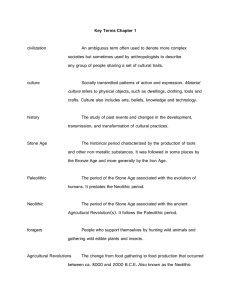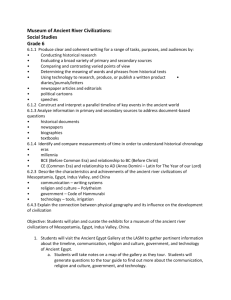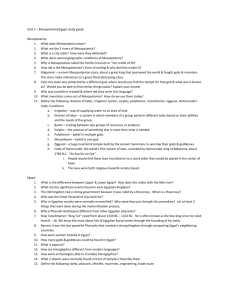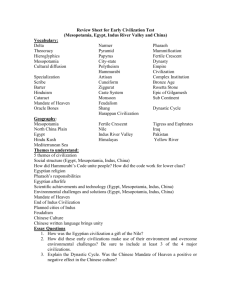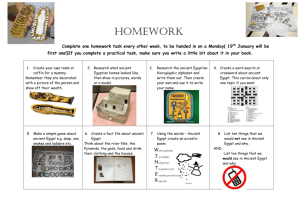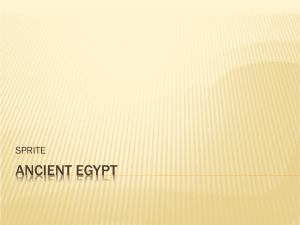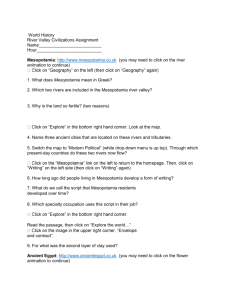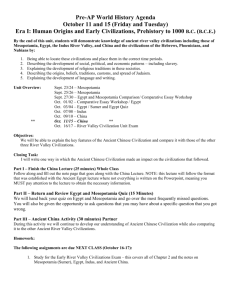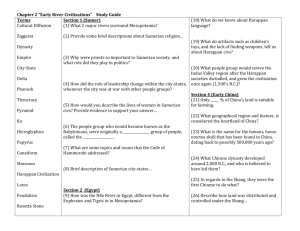Chapter 2
advertisement
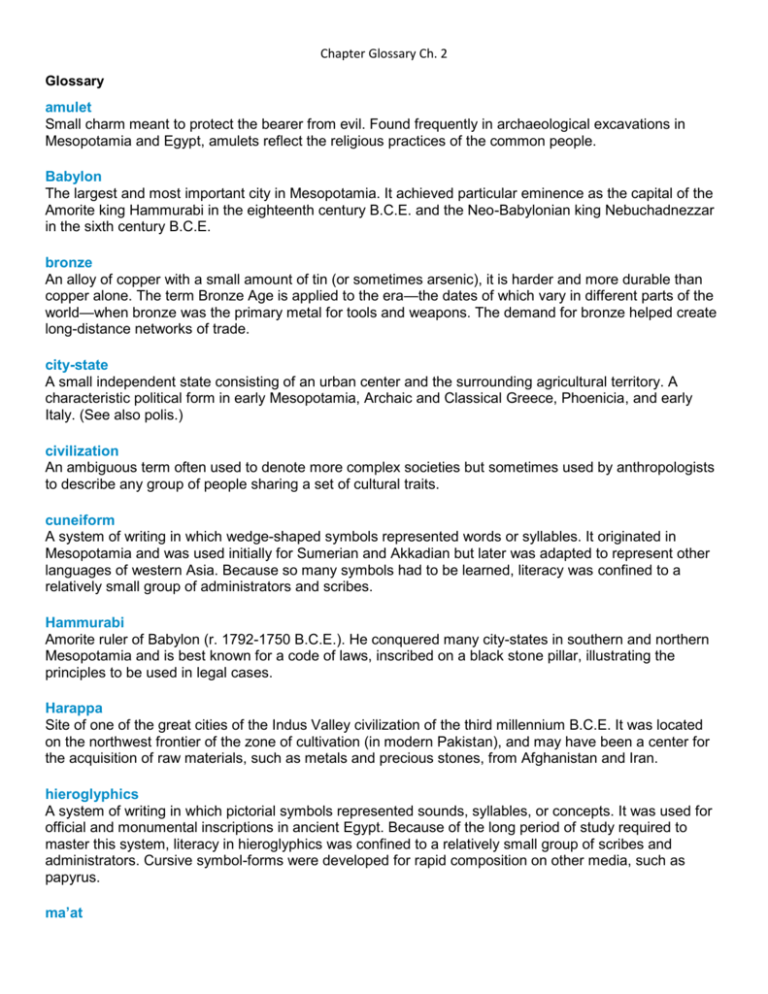
Chapter Glossary Ch. 2 Glossary amulet Small charm meant to protect the bearer from evil. Found frequently in archaeological excavations in Mesopotamia and Egypt, amulets reflect the religious practices of the common people. Babylon The largest and most important city in Mesopotamia. It achieved particular eminence as the capital of the Amorite king Hammurabi in the eighteenth century B.C.E. and the Neo-Babylonian king Nebuchadnezzar in the sixth century B.C.E. bronze An alloy of copper with a small amount of tin (or sometimes arsenic), it is harder and more durable than copper alone. The term Bronze Age is applied to the era—the dates of which vary in different parts of the world—when bronze was the primary metal for tools and weapons. The demand for bronze helped create long-distance networks of trade. city-state A small independent state consisting of an urban center and the surrounding agricultural territory. A characteristic political form in early Mesopotamia, Archaic and Classical Greece, Phoenicia, and early Italy. (See also polis.) civilization An ambiguous term often used to denote more complex societies but sometimes used by anthropologists to describe any group of people sharing a set of cultural traits. cuneiform A system of writing in which wedge-shaped symbols represented words or syllables. It originated in Mesopotamia and was used initially for Sumerian and Akkadian but later was adapted to represent other languages of western Asia. Because so many symbols had to be learned, literacy was confined to a relatively small group of administrators and scribes. Hammurabi Amorite ruler of Babylon (r. 1792-1750 B.C.E.). He conquered many city-states in southern and northern Mesopotamia and is best known for a code of laws, inscribed on a black stone pillar, illustrating the principles to be used in legal cases. Harappa Site of one of the great cities of the Indus Valley civilization of the third millennium B.C.E. It was located on the northwest frontier of the zone of cultivation (in modern Pakistan), and may have been a center for the acquisition of raw materials, such as metals and precious stones, from Afghanistan and Iran. hieroglyphics A system of writing in which pictorial symbols represented sounds, syllables, or concepts. It was used for official and monumental inscriptions in ancient Egypt. Because of the long period of study required to master this system, literacy in hieroglyphics was confined to a relatively small group of scribes and administrators. Cursive symbol-forms were developed for rapid composition on other media, such as papyrus. ma’at Egyptian term for the concept of divinely created and maintained order in the universe. Reflecting the ancient Egyptians’ belief in an essentially beneficent world, the divine ruler was the earthly guarantor of this order. (See also pyramid.) Memphis The capital of Old Kingdom Egypt, near the head of the Nile Delta. Early rulers were interred in the nearby pyramids. Mohenjo-Daro Largest of the cities of the Indus Valley civilization. It was centrally located in the extensive floodplain of the Indus River in contemporary Pakistan. Little is known about the political institutions of Indus Valley communities, but the large-scale of construction at Mohenjo-Daro, the orderly grid of streets, and the standardization of building materials are evidence of central planning. mummy A body preserved by chemical processes or special natural circumstances, often in the belief that the deceased will need it again in the afterlife. In ancient Egypt the bodies of people who could afford mummification underwent a complex process of removing organs, filling body cavities, dehydrating the corpse with natron, and then wrapping the body with linen bandages and enclosing it in a wooden sarcophagus. papyrus A reed that grows along the banks of the Nile River in Egypt. From it was produced a coarse, paperlike writing medium used by the Egyptians and many other peoples in the ancient Mediterranean and Middle East. pharaoh The central figure in the ancient Egyptian state. Believed to be an earthly manifestation of the gods, he used his absolute power to maintain the safety and prosperity of Egypt. pyramid A large, triangular stone monument, used in Egypt and Nubia as a burial place for the king. The largest pyramids, erected during the Old Kingdom near Memphis with stone tools and compulsory labor, reflect the Egyptian belief that the proper and spectacular burial of the divine ruler would guarantee the continued prosperity of the land. (See also ma’at.) scribe In the governments of many ancient societies, a professional position reserved for men who had undergone the lengthy training required to be able to read and write using cuneiforms, hieroglyphics, or other early, cumbersome writing systems. Semitic Family of related languages long spoken across parts of western Asia and northern Africa. In antiquity these languages included Hebrew, Aramaic, and Phoenician. The most widespread modern member of the Semitic family is Arabic. Sumerians The people who dominated southern Mesopotamia through the end of the third millennium B.C.E. They were responsible for the creation of many fundamental elements of Mesopotamian culture—such as irrigation technology, cuneiform, and religious conceptions—taken over by their Semitic successors. Thebes Capital city of Egypt and home of the ruling dynasties during the Middle and New Kingdoms. Amon, patron deity of Thebes, became one of the chief gods of Egypt. Monarchs were buried across the river in the Valley of the Kings. ziggurat A massive pyramidal stepped tower made of mud bricks. It is associated with religious complexes in ancient Mesopotamian cities, but its function is unknown.

